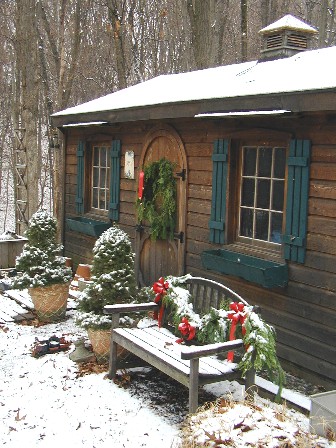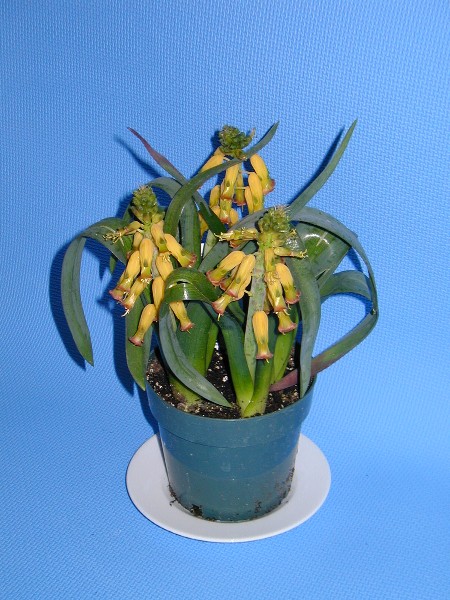
I was talking to Jerry today. As well as complimenting me on the recent Diary entries, he mentioned that recently he had found the lachenalia I photographed in the Wave Hill conservatory. "Where?" I asked, figuring it was one of the far-flung nurseries he's fond of visiting. "Shoprite." he calmly replied. Now, it's true that uncommon things occasionally turn up there, such as the Scilla peruviana I found a couple of years ago. More often though, it's the usual sort of potted impulse plants - baby narcissus, primroses, miniature roses.
Later, in the afternoon, I stopped by to visit with Jerry and Bea, bringing a flourless orange almond cake which we sampled. Very civilized, afternoon coffee and cake. And of course I looked at his lachenalia, which indeed was Romaud®. Of course, compared to the Wave Hill pot, Jerry's looked like they'd been dosed with some sort of horticultural steroid, with huge thick stems and large spikes of flowers.
So off I went to Shoprite. I did need apples and asparagus. It's mere happenstance that the cut flowers and potted plants are between the entrance and the produce section. There were some pots of Romaud®, but the stems were rather floppy. There were pots of Rosabeth®, with lovely green-tipped rose-pink flowers. However each pot had several broken or wilted flower stalks, and only one in bloom. At $12.99 per pot, I wanted something better than that (though I may go back and see if we can make a deal.) And then I found it - one pot with short, sturdy, well-filled flower spikes. Yet a third cultivar, Fransie® has terra-cotta red-tipped yellow flowers. These are three selections in the African Beauty® range, which I first saw in 2002 when I was in Holland. UPDATE: And on Wednesday, at another Shoprite I found delicately translucent lavender Rupert® for sale.
Thanks to Wave Hill, Jerry, the Dutch growers, and my supermarket, for nicely rounding out a gardenesque circle of plants and people that sent me home with a pot of lachenalia to enjoy.
For those of you unfamiliar with this charming genus of South African bulbs, they're easy to grow. Provide ample sunshine and cool temperatures. 50° Fahrenheit is fine. They are naturally winter growing, and should be kept moist while in active growth. Gradually dry off in spring, keep dry in summer, and re-pot at summer's end. They make lots of offsets, and will quickly bulk up to make a nice full pan.

The greatest benefit of a greenhouse / conservatory is flowers in the winter garden. Fuel costs spiralling out of sight, those plants that A) flower in winter and B) thrive (not merely survive, mind you) in cooler temperatures are highly desirable. Bulbs offer us one group of flowers that bloom on a winter windowsill. Pot up daffodils, tulips, and hyacinths at the same time as you are planting them in the autumn, and 16 weeks later or thereabouts, they'll bloom indoors, convinced that winter has come and gone away again.
As refreshing and welcome as are these deluded harbingers of spring, there's another group of bulbs that naturally bloom in winter. Native to South Africa, their response is not so much to a period of cold followed by a warming trend, as it is to a warm dry dormancy followed by moisture. Their Mediterranean cycle is summer dry, winter wet.
Wave Hill's conservatory makes good use of this habit, and Cherie, Nora, and I were delighted with what's in bloom. Staging enhances the display. Rather than isolated pots, groupings are arranged to create charming vignettes. For example, conside the pots of dainter bulbous lachenalia and cormous moraea. Arranged on a chest-high shelf they are brought up into view where their complementary colors can be better appreciated. Somewhat floppy foliage is discretely managed with arching hoops of florist's wire, the ends tucked into the soil and the wires intersecting chords holding things loosely in place for a very natural look rather than plants in bondage.
Given today's damp weather and its location just beyond the hedge that screens the parking lot, a flower-filled conservatory exerts a powerful attraction for winter-weary gardener lovers. As may be seen in Wave Hill in Winter posted on 8 January, there's a tall and stately center glasshouse, with a wing to either side. Behind the main display house is what's termed the head house, or work area for greenhouse and garden. The doorway between the two is open, secured merely with a chain and a discreet sign that notes the area is closed to the public. But we can certainly peer inside. There's a pegboard of tools, a sink, and lots of intreguing things. Hearing voices, I leaned over the "keep out" chain and said, "Excuse me, but could I step just over the chain to take a picture?" Turning around, the gardener said, "Judy?" It was Susannah, who (two years ago) was a student of mine in the Ornamental Herbaceous Plants: Bulbs course that I taught at The New York Botanical Garden. Happy greetings, unhooked chain, and Cherie, Nora, and I walk into the well-supplied and immaculately kept work area and indoor tool shed. A pleasant few minutes of catch-up, what's doing with you sort of conversation, and it's time for us three visitors to head off to Wave Hill House for the Cooking with Conifers lecture.
It is amazing what a difference three little weeks can make, especially in January. Granted, the weather has been positively mild. (Something Paul's friend Woody says has a correlation to the very wet October. In turn, a mild January is often followed by a chiller than usual March. However let's not go there just yet.) No complaints about rain rather than snow. I just wish today's jaunt off to Wave Hill had been in mild and sunny weather, rather than mild and overcast with rain likely. No matter. Today's lecture on Cooking with Conifers sounded interesting, and my friend Cherie said she'd meet me there, accompanied by her friend Nora. So this and that accomplished early in the morning and off I set on a solo drive across New Jersey (fortunately a skinny state) and the George Washington Bridge. Park the car, follow the brick path, and there's Cherie and Nora waiting for me.
An enthusiastic gardener, like the rest of us impatient for spring and having withdrawal symptoms while awaiting its arrival, Cherie's never been to Wave Hill before. Nora has, but welcomed the opportunity to hang out with like-minded folks in a beautiful landscape with marvellous trees.
There's all sorts of ways to visit gardens. Some people go and just soak up the ambience, enjoying a respite from hectic days and city life. Others, while enjoying themselves just as much, prefer to add research and learning to their outing. Camera and notebook in hand, records written or photographic provide something to take home.
Bonnie and I were here three weeks ago, when the garden was still sound asleep. Today it begins to stir. There are the first black catkins of Salix gracilistyla 'Melanostachys' opening on red-barked twigs. Nothings open on Cornelian cherry, Cornus mas, but the buds are swelling like miniature ballons ready to pop. Viburnum farreri has the first pale flowers open in each tight cluster of red buds strewn along the naked branches. Few enough, yet sufficient to explain why it has the common name of Fragrant Viburnum. It's the witch hazels though, that greet the end of winter and offer up their flower-wreathed branches as sign and signal of the turning seasons.
The fog, wrote Carl Sandberg, creeps in on little cat feet. A decade ago when I chose two kittens at the SPCA animal shelter they were two small dust balls of platinum and pewter, obviously the weather twins and accordingly named Fog and Mist. Her face was a little daintier; he, more outgoing in personality. As they matured he remained the bolder of the two, convinced that the world is filled with generous people to open doors and provide laps for sitting on. Yesterday, for example, when John and Carol came over for dinner and the four of us were sitting at the kitchen table Fog moved from Carol's lap to Paul's arms, around into John's lap and even managed time in mine (though I was up and down, finishing the cooking.)
Mist, for whatever reason, is timid, the classic "scairdy cat." Less outgoing than her brother, when the doorbell rings she darts down the stairs to hide in the basement. At home alone with us, she's placid, comes to talk to me, sit on the table near my computer, curls up in my lap. Today's daylight hours are drawing to a close with some wind roughly combing through the treetops. When I sat down to check the weather forecast on the television, Mist curled into a warm furry ball in my lap, in perfect comfort for the two of us. It seemed a shame to dump her to the floor when I got up. A lap robe on the chair, the cat nestled down, and Mist settled in for an extended snooze.
Back in September, the bananas in the garden came indoors for the winter. (You can see Bananas on the Move in the September Fourth Week Diary entry.) It's more than three months later. We've had snow, temperatures tickling just below zero Fahrenheit - clearly this was a good idea as they'd never have made it out of doors. The Japanese fiber banana, Musa basjoo, that remains in the garden stands a better chance. It's hardier, been cut back, and the big culms each insulated with a plastic garbage can filled with pine straw.
The large banana is in the great room, it's smaller sibling (I chopped it off as an outsize pup last spring) is in my bedroom, thriving under the skylights. By now I have become accustomed to looking beyond the foot of my bed at this outsized house plant, and can even manuever around it in the dark. It has a couple of small pups of it's own. This might become a problem. One pot of bananas in the bedroom is fine. A grove of them would be another matter.
Wave Hill is a garden for all seasons. I visited it twice in June 2005, which only made me think of when I lived in Connecticut. Then I might visit twice a week, after a morning spent teaching at The New York Botanical Garden. It seemed like a pleasant start to the new year, to drive up with my friend Bonnie. We'd stroll around the grounds, enjoy lunch at the cafe, and then attend a free afternoon lecture on natural teas and remedies. The weather cooperated, relatively mild (for early January anyhow) and sunny.
Bonnie had never been to Wave Hill, so I had the pleasure of telling her what a treat awaited her. Happily chatting away as we headed north and easterly, we arrived in good time thanks to Sunday's light traffic. Into the parking lot, down the path - and there before us is the splendid view of the Hudson River and the Pallisades of New Jersey. A few minutes to enjoy it, and then a right turn through the rustic Adirondack-style fence enclosing a dormant garden, and into the conservatory.
A slow stroll through the glasshouse (open from 10:00 a.m. until noon, and 1:00 to 4:00 p.m.) looking at some familiar plants and others completely new to us both. Outdoors, and up the road to the alpine house. Carefully locked though the door might be, the side windows had been removed to keep things cool. An alpine house, you see, is generally heated to just above freezing. And today's sunshine could easily heat things well above that. There were pans of cyclamen in bloom, some attractive, though dormant, saraccenia, alpines, little shrubs, and even a Japanese maple.
On the way to Wave Hill House where the cafe is located and where the lecture would be held we stopped to admire the colorful bark of a group of shrubs. The rich orange russet is that of a willow, Salix alba 'Chermesina'. Another willow, Salix gracilistyla 'Melanostachys', is not expecially noticeable at this time of year. Soon though, it will display its large black pussy willows. Cornus sericea forma stolonifera is a shrubby dogwood often grown for the vivid red bark on young shoots. Just for something different, here's the cultivar 'Flaviramea', with greeny yellow bark. Growth on willows and dogwoods, and trees such as catalpa and Pawlonia can be controlled through a technique called stooling. The growth on a young but establish plant is cut down to within a foot or so of the ground. New shoots appear and grow rapidly. The leaves are generally much larger than is typical.
As much as there is to see, even at this dormant time of year, we had decided to have lunch. The menu, delicious as always, offered two soups, a few sandwiches, and a couple of salads. In perfect harmony Bonnie and I both decided on a cup of seafood sausage gumbo and a grilled vegetable foccacia. I had a hazelnut mocha, and decided to call it dessert. The terrace looked appealing, but there was a small breeze and I wanted my soup to stay hot while I ate it. The pleasant room with tall windows and comfortable cafe-style tables and chairs would be a better choice today. A young family did go outdoors to eat. Maybe next time we assured each other.
It was certainly comfortable enough walking around. Sitting still, unless sheltered by a hedge or a wall is a different matter. So we strolled, enjoying the contrast of bare branches and evergreen shrubs and trees, mostly dormant perennials and a few with evergreen leaves. Some, such as hellebores and boxwoods, were cosily tucked in for the winter with a mulch of conifer boughs. An excellent way to dispose of Christmas trees once the holiday has passed, plants are protected from drying winds and sun scald when its cold.
The afternoon lecture, expected to draw a modest audience of perhaps 15 filed the room to capacity. Tea plays an important role in many cultures- just think of afternoon tea in England or a tea ceremony in Japan. Today's talk was not about not Camellia sinensis but rather more about herbal infusions, brewed beverages other than what's commonly thought of as tea. This one in the for morning, another for afternoon, something for difficult urination, and more. Leaf tea better than tea bags. Use water just off the boil, and wet the leaves with just a little water. Swirl it around, discard the liquid, and then make your brew. This removes dust, and caffine. We sampled two or three infusions. Interesting, but not well organized, especially with so many participants eager to have a taste. "Time to go." I whispered to Bonnie. Ninety minutes had gone by, the talk was not yet concluded, and we had a 75 mile drive ahead of us.
When the weather gets cold birds fluff their feathers. We humans put on more clothes. Some plants have previously prepared by dropping their leaves. What's an evergreen shrub's solution to wintry conditions? If the shrub is a conifer - yew, for example - there's no problem, as it's needle-like foliage has limited surface area, and a resinous coating that reduces water loss. Evaporation / transpiration is the problem, you see. Moisture lost from the leaves of broad-leaved evergreens while the ground is frozen cannot be replaced. In the worst case scenario, leaves become brown, crispy, and dead at the edges, a condition known as "winter-burn." Sometimes the entire leaf dies. Avoid planting broad-leaved evergreens where they'll be exposed to sunlight first thing in the morning, before the air begins to warm from overnight low temperatures. Consider using an anti-transpirant spray. These provide a thin coating over the leaves and protect against water loss. Timing will depend on where you live. In New Jersey and sites that are in a similar zone apply in late November or early December. Make sure the air temperature is above freezing, and will remain there until the spray dries. Reapply during the January thaw, to replace any coating than has been worn away by snow and rain.
Rhododendrons protect themselves to a certain extent, by curling their leaves, reducing their ability to transpire and lose moisture. There is some variation from species to species, and I suppose a "thermometer" could be developed, noting at which temperature what ones curled.
Sign of the season - a dusting of snow late in the day before new year's eve. Remarkably local, as we had sufficient to whiten the ground while Flemington got only a dusting. Regardless, it provided an appropriately wintry look to the landscape on New Year's Day/
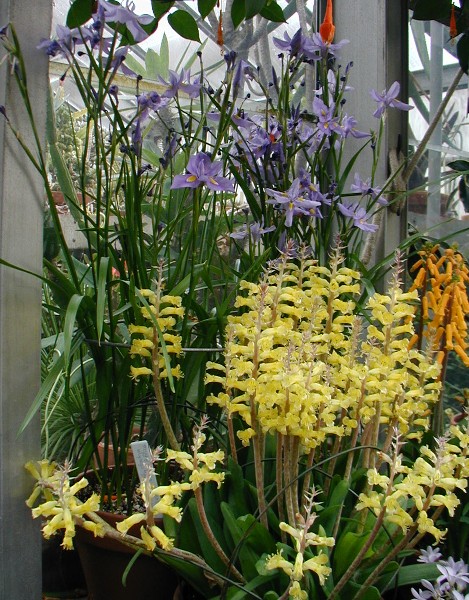
with the iris-like blue flowers of Moraea polystachya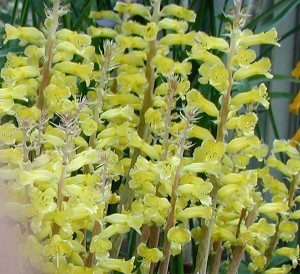
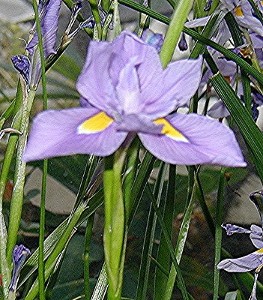
The rather coarse, sword-like leaves and bolder scale of the flower spikes necessitates setting the pots on the floor,
with other plants trailing foliage concealing the mechanics of pots and staking.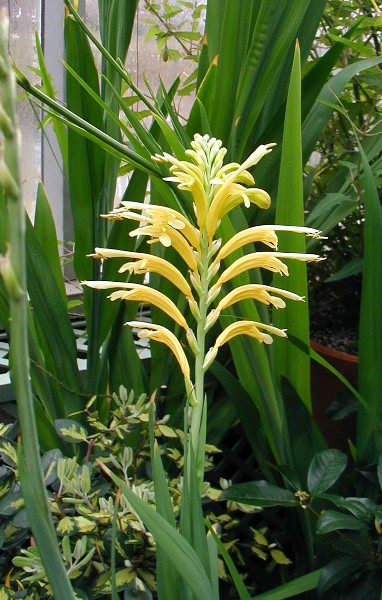
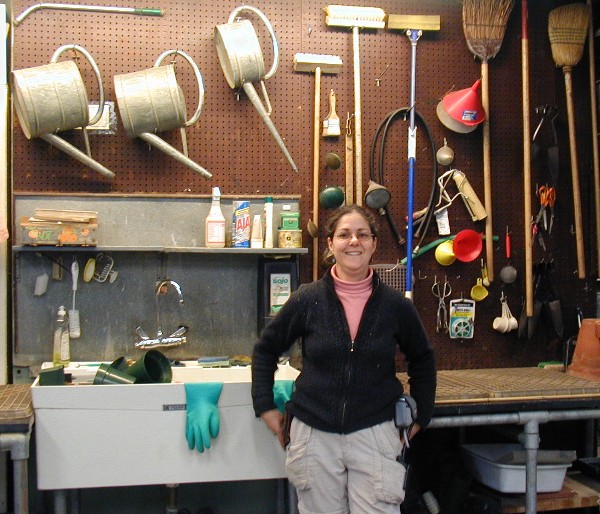
while behind her an orderly array of watering cans and more hang from the peg board.
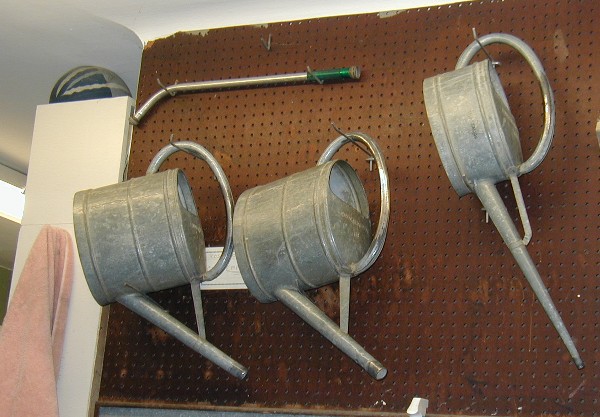
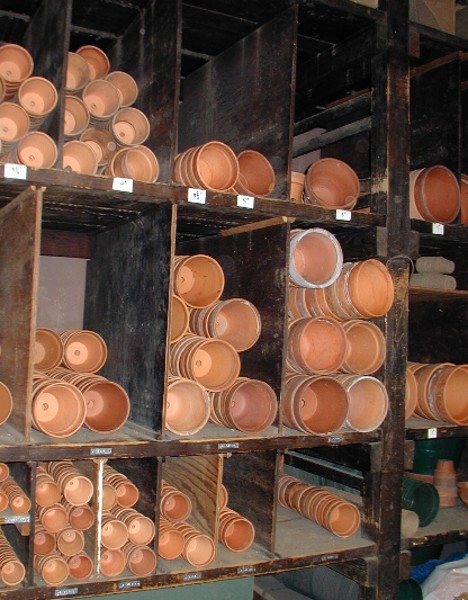
"We use mostly clay here at Wave Hill," muses Susanne, "and very little plastic."
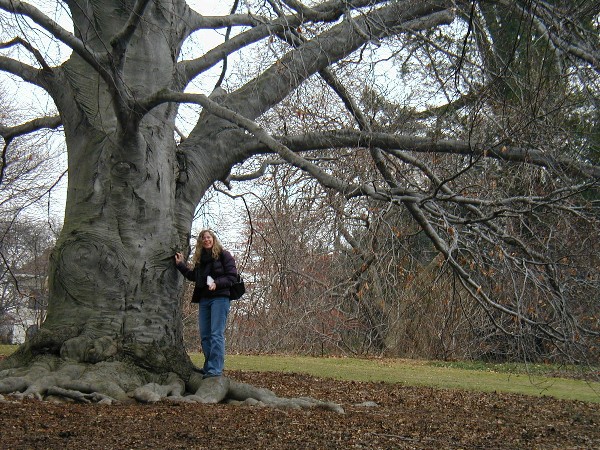
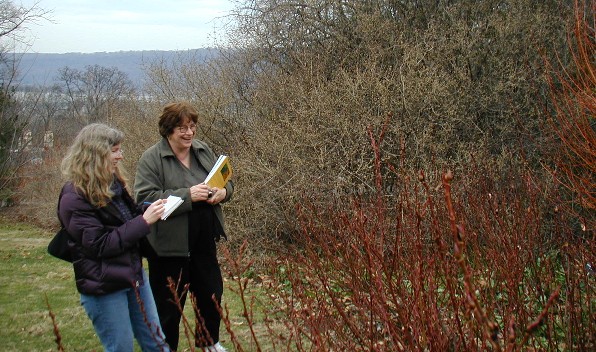
or whenever we next go shopping for the garden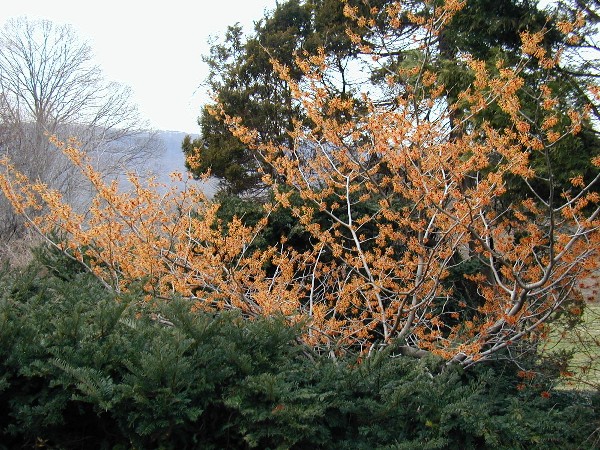
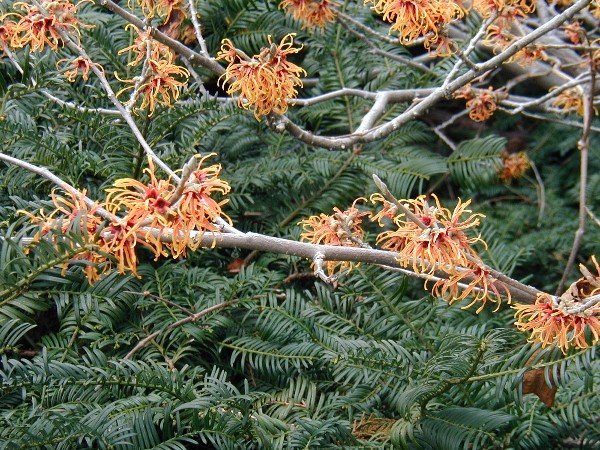

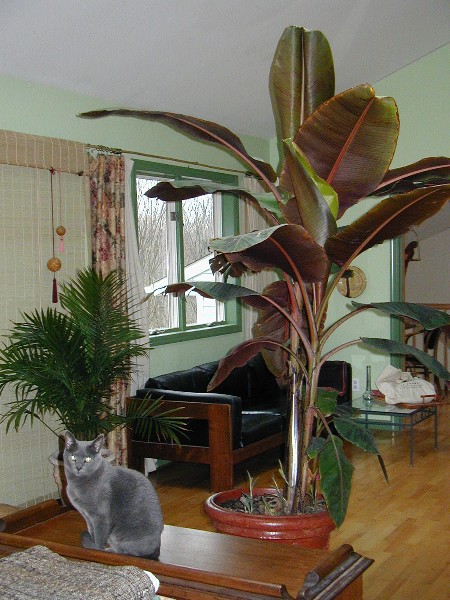
in the palm and banana, jungle-like ambience of my bedroom
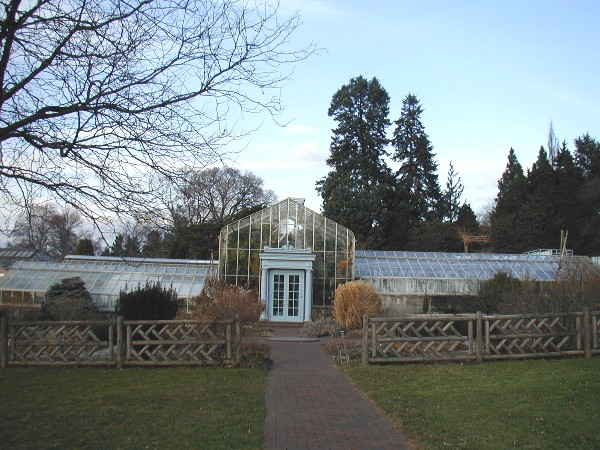
to some permanent cast members, and a constantly changing support team "on display" at their best.
The wing you see to the left contains tropical plants, the other wing houses cacti and succulents.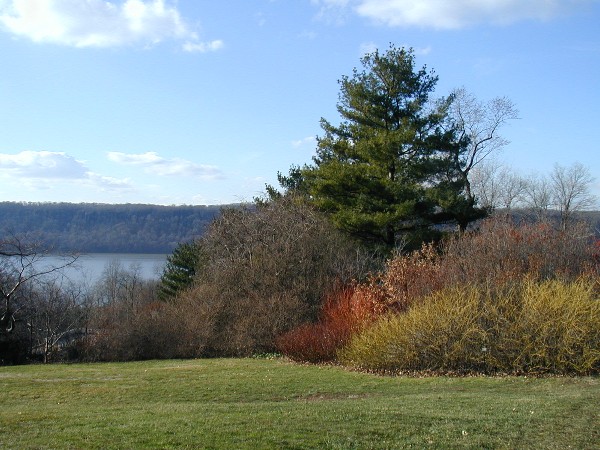
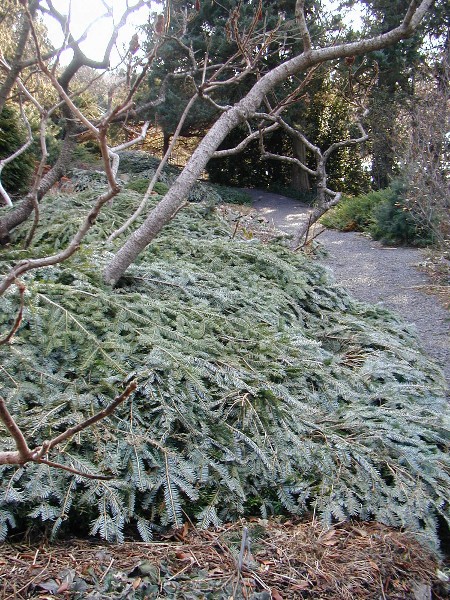
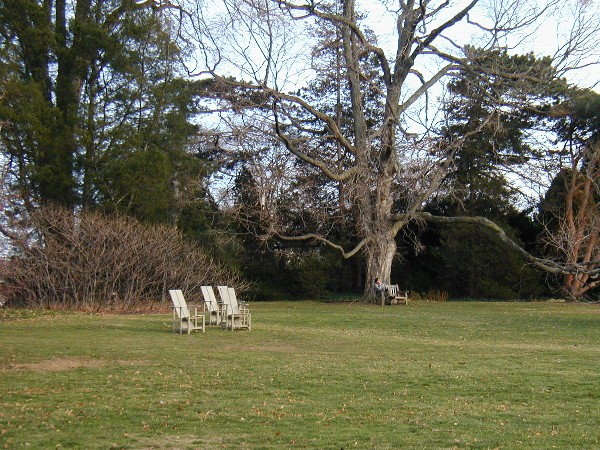
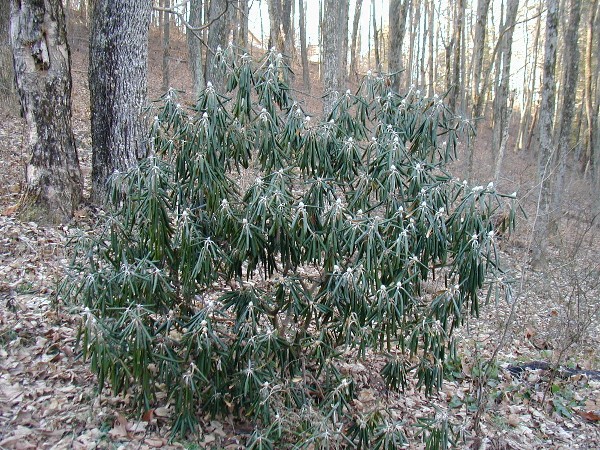
named for Yaku Shima, Japan, where it was originally found as a wild plant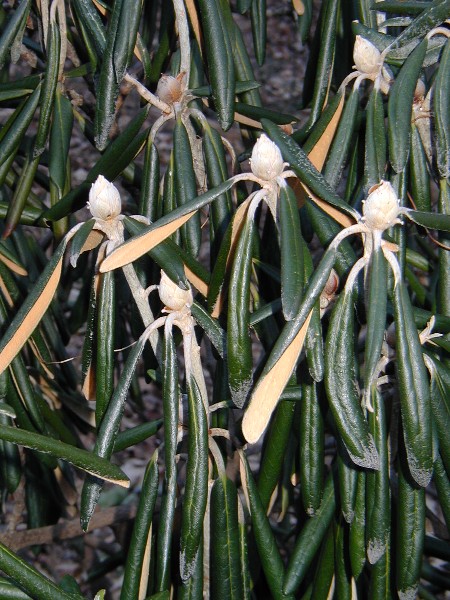
which also reduce water loss. With temperatures in the 20s Fahrenheit, its leaves protectively curl up
